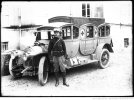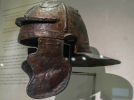You are using an out of date browser. It may not display this or other websites correctly.
You should upgrade or use an alternative browser.
You should upgrade or use an alternative browser.
Cool History Stuff
- Thread starter Rico
- Start date
In other news, I read yesterday that Gorbachev just passed at 91 years of age.
Nah... thats not Putin surely...

Is Vladimir Putin the mystery man in the picture?
Is the blond youth dressed as a tourist actually a tourist? Or does photograph show an undercover KGB spy, now better known as Vladimir Putin?
It's debated...
- Joined
- Oct 11, 2010
- Messages
- 13,111
- Reaction score
- 8,129
- Age
- 61
It's definitely him here: Gorbachev & Putin discuss democracy at the Nevsky Palace restaurant, St Petersburg. 1994


Looks like they are discussing the menu.
I wonder what year it was on the Pontus calendar.
Thanks for posting this, it caused me to do a little more research.
When you said "Getty Villa LA" I thought you meant Louisiana not Los Angeles. LA is the state acronym for Louisiana like NY is for New York.
I had to think to my self why Louisiana?
I know Getty was big time filthy rich and quite the philanthropist so I looked it up Getty Villa and found out it is in Los Angeles and a very impressive place too.
"Getty Villa Museum
Greek and Roman antiquities housed in a re-created Roman country home
Step into the Ancient World
A one-of-a-kind destination offering ancient Greek and Roman art, tranquil gardens, and ocean breezes."
Thanks for posting this, it caused me to do a little more research.
When you said "Getty Villa LA" I thought you meant Louisiana not Los Angeles. LA is the state acronym for Louisiana like NY is for New York.
I had to think to my self why Louisiana?
I know Getty was big time filthy rich and quite the philanthropist so I looked it up Getty Villa and found out it is in Los Angeles and a very impressive place too.
"Getty Villa Museum
Greek and Roman antiquities housed in a re-created Roman country home
Step into the Ancient World
A one-of-a-kind destination offering ancient Greek and Roman art, tranquil gardens, and ocean breezes."
Interesting that his shield was created one year after is reign ended.
In the words of Maxwell Smart: "That's the second biggest gun I've ever seen."
My wife and I were in D.C and we stopped in Arlington National Cemetery and had a chance to watch the changing of the guard at the Tomb of the Unknown Soldier.
It was very moving. Very serious.
The crowd was very quiet.
Some facts about the Guards.
1. They don’t wear rank insignia for a reason
Unlike every American soldier, sailor, airman or Marine, the guards at the Tomb of the Unknown Soldier do not wear rank insignia on their coats when guarding the tomb. Since the fallen inside the tomb are unknown, and no one knows what rank they actually were, Tomb Guards don’t wear visible rank so they don’t outrank who they might be guarding.
Only when the relief commanders come out to change the guard, do they wear an NCO’s rank. Their actual rank is separate from the uniform they wear while on duty at the tomb.
2. The Tomb Guard Badge is the 3rd least awarded badge in the Army
In third place behind the Military Horseman Identification Badge and the Astronaut Badge, acquiring the Tomb of the Unknown Soldier Guard Identification Badge is not just rare, it’s incredibly difficult. Only 20% of applicants are accepted for training and the washout rate is astronomical.
3. It’s not a job, it’s a lifestyle.
This is not just a lifestyle in the way that the Army life is a different way of life. When serving as a Tomb Guard, the job becomes your life for 18 months. The average sentinel take 8 hours to prepare everything required to go on duty for his next and that shift is a 24-hour shift.
4. Being on duty means the world’s strictest schedule
Tomb Sentinels stand two-hour watches in 24 hour shifts. In that time, they will repeatedly count to 21, which is representative of the 21-gun salute, the highest military honor given. The guard’s motions are a seven step process.
Tomb sentinel
A 21 step march down the 63-foot-long black mat.
A turn toward the Tomb for 21 seconds.
A turn and face the opposite direction of the mat, weapon change to outside shoulder, and wait 21 seconds.
March 21 steps down the mat.
Turn and face the tomb for 21 seconds.
Turn and face the opposite direction, weapon shifted to outside shoulder, and wait 21 seconds.
Repeats the routine until the soldier is relieved at the Changing of the Guard.
5. The weapons and the gloves used to handle them are special
The gloves worn by Tomb Sentinels are usually wet to give them better control of the rifle in their hand as they switch it from shoulder to shoulder. Their weapons are special versions of whatever infantry rifle is standard issue at the time they’re posted, with ceremonial stocks. Currently, they use a fully functional but unloaded and well-cleaned M-14.
Non-commissioned officers wear a special sidearm during the Changing of the guard ceremony. The pistol is also whatever standard-issue is for the Army, but Sig-Sauer, the company that makes the Army’s standard-issue sidearm, created four special pistols just for the Old Guard, which includes wood from a ship that served in the Spanish-American War.
Read: These pistols are carried by NCOs at the Tomb of the Unknowns
6. The guards aren’t there for show
The Army originally placed guards at the Tomb of the Unknown to deter picnickers from having lunch on top of the hallowed gravesite.
In the years that followed, the guards are posted to keep people from defacing or touching the monument or even failing to show proper respect.
They will take steps to deter any encroachment on the tomb, by any means necessary.
It was very moving. Very serious.
The crowd was very quiet.
Some facts about the Guards.
1. They don’t wear rank insignia for a reason
Unlike every American soldier, sailor, airman or Marine, the guards at the Tomb of the Unknown Soldier do not wear rank insignia on their coats when guarding the tomb. Since the fallen inside the tomb are unknown, and no one knows what rank they actually were, Tomb Guards don’t wear visible rank so they don’t outrank who they might be guarding.
Only when the relief commanders come out to change the guard, do they wear an NCO’s rank. Their actual rank is separate from the uniform they wear while on duty at the tomb.
2. The Tomb Guard Badge is the 3rd least awarded badge in the Army
In third place behind the Military Horseman Identification Badge and the Astronaut Badge, acquiring the Tomb of the Unknown Soldier Guard Identification Badge is not just rare, it’s incredibly difficult. Only 20% of applicants are accepted for training and the washout rate is astronomical.
3. It’s not a job, it’s a lifestyle.
This is not just a lifestyle in the way that the Army life is a different way of life. When serving as a Tomb Guard, the job becomes your life for 18 months. The average sentinel take 8 hours to prepare everything required to go on duty for his next and that shift is a 24-hour shift.
4. Being on duty means the world’s strictest schedule
Tomb Sentinels stand two-hour watches in 24 hour shifts. In that time, they will repeatedly count to 21, which is representative of the 21-gun salute, the highest military honor given. The guard’s motions are a seven step process.
Tomb sentinel
A 21 step march down the 63-foot-long black mat.
A turn toward the Tomb for 21 seconds.
A turn and face the opposite direction of the mat, weapon change to outside shoulder, and wait 21 seconds.
March 21 steps down the mat.
Turn and face the tomb for 21 seconds.
Turn and face the opposite direction, weapon shifted to outside shoulder, and wait 21 seconds.
Repeats the routine until the soldier is relieved at the Changing of the Guard.
5. The weapons and the gloves used to handle them are special
The gloves worn by Tomb Sentinels are usually wet to give them better control of the rifle in their hand as they switch it from shoulder to shoulder. Their weapons are special versions of whatever infantry rifle is standard issue at the time they’re posted, with ceremonial stocks. Currently, they use a fully functional but unloaded and well-cleaned M-14.
Non-commissioned officers wear a special sidearm during the Changing of the guard ceremony. The pistol is also whatever standard-issue is for the Army, but Sig-Sauer, the company that makes the Army’s standard-issue sidearm, created four special pistols just for the Old Guard, which includes wood from a ship that served in the Spanish-American War.
Read: These pistols are carried by NCOs at the Tomb of the Unknowns
6. The guards aren’t there for show
The Army originally placed guards at the Tomb of the Unknown to deter picnickers from having lunch on top of the hallowed gravesite.
In the years that followed, the guards are posted to keep people from defacing or touching the monument or even failing to show proper respect.
They will take steps to deter any encroachment on the tomb, by any means necessary.
- Joined
- Oct 11, 2010
- Messages
- 13,111
- Reaction score
- 8,129
- Age
- 61
Interesting. Majestic. !!My wife and I were in D.C and we stopped in Arlington National Cemetery and had a chance to watch the changing of the guard at the Tomb of the Unknown Soldier.
It was very moving. Very serious.
The crowd was very quiet.
Some facts about the Guards....
Think I will pass on that drinkIn 350 AD this Roman bottle of wine was sealed with wax and was unearthed in 1867. It is on display at the Pfalz Historical Museum in Germany. The wax seal is the 5cm layer of yellow wax inside the bottle, creating an airtight seal, theoretically making it drinkable...
View attachment 27980













































































































































